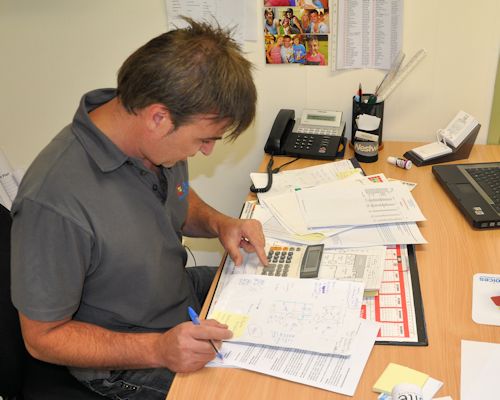Writing up the quotation
 Audio for slide 1 (mp3 |6|KB)
Audio for slide 1 (mp3 |6|KB)
Once you get back to the office, you can calculate the costs and prepare the quotation.
A good way to start is to develop a work plan for the project. This will include:
- details of the materials to be used in the installation
- delivery and access arrangements
- sub-floor preparation required
- coatings or finishing work to be done
- number of hours needed to carry out each aspect of the job timetable for the whole project.

 Audio for slide 3 (mp3 |6|KB)
Audio for slide 3 (mp3 |6|KB)
The quotation itself is the formal document that you give to the client, describing what you plan to do and how much you'll charge in total. As a minimum, a quotation should include the following information:
- reference number and date
- your business name, address, contact details and ABN
- client's name, address and contact details
- address of the jobsite
- description of the work to be done
- total price for the installation job, and a breakdown of the costings if required
- period of time the quote is valid for
- terms and conditions, such as payment schedule and any contractual requirements
- provision for a company representative's signature.
The link below will take you to an example of a typical quotation.

 Audio for slide 4 (mp3 |6|KB)
Audio for slide 4 (mp3 |6|KB)
Following up on the quotation
Once you submit the quote, some clients will give you an approval straight away and say: 'When can you start?'.
Others will let it sit while they get other quotes, or consider their finances, or wait for other building work to be completed first.
If you haven't heard from the client within a few days of submitting the quote - don't be afraid to ring up and ask whether they wish to go ahead.
Clients like to deal with pro-active installers, because it demonstrates that they're keen and businesslike.

 Audio for slide 5 (mp3 |6|KB)
Audio for slide 5 (mp3 |6|KB)
If the client decides not to give you the go-ahead, file the quote away for future reference. The costings may be handy for another quotation, or the client may come back some time later with a modified enquiry or even an approval on your original quote.
For projects that are approved, make sure you re-confirm the details and ask the client to sign a contract. The typical procedure is as follows:
- Confirm the flooring colours, measurements and timeframe with client.
- Check the availability of the products to make sure there won't be any glitches or long waiting times.
- Send the client a contract to sign, and receive a deposit for the project.
Once you've committed the client to a formal agreement, you can order in any special materials and put aside stock items for the project.

Learning activity
 Audio for slide 6 (mp3 |6|KB)
Audio for slide 6 (mp3 |6|KB)
Are you familiar with the quotation documents that your company uses?
Ask your boss if you can have a look at a typical quotation, preferably one that relates to a project you're working on at the moment.
Compare your company's quotation layout with the sample quotation for a domestic job that we looked at earlier.
Is there any additional information in your company's version that isn't in this sample document? If so, what is the purpose of this information?

 Go to Maintaining records
Go to Maintaining records